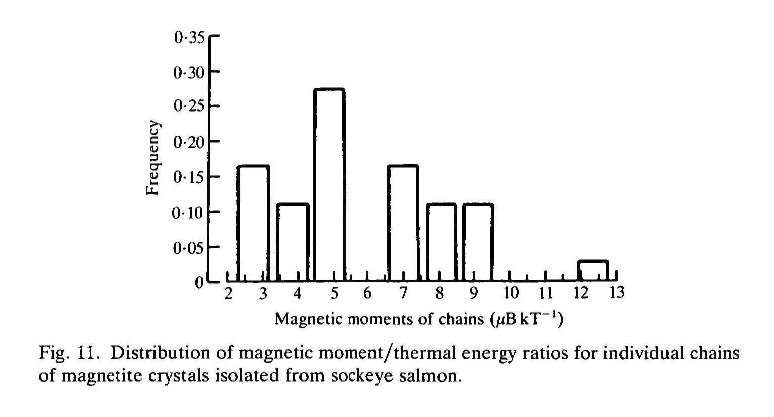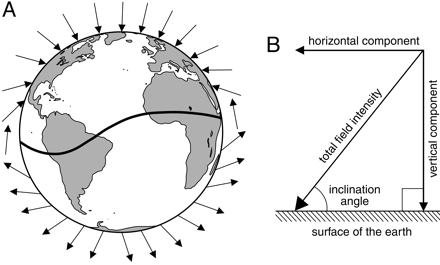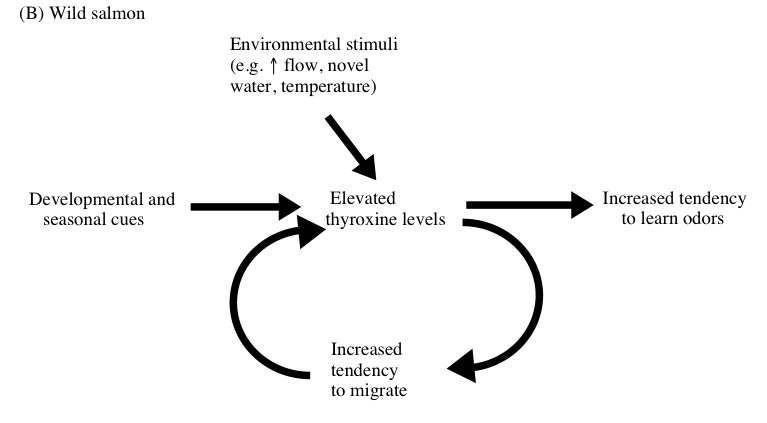MIGRATORY PATTERNS OF CHINOOK SALMON
Biology 342 Fall 2012
Tess Tumarkin & Erin McAllester
Mechanism
The Mechanism section from the Tinbergen table on the home page states: what are the mechanical (or causal) relationships between stimuli and the behavioral response?
What particular mechanistic questions come to mind when considering migratory behavior in Chinook salmon? How do the salmon ‘know’ where to go? What cues are available to help them navigate? How do they ‘remember’ signals from when they were fry or smolts (possibly 8 years previous to their migration)?
The hypothesis is that Chinook salmon operate with a biphasic model of navigation, including both magnetic and olfactory cues.
First Phase: Magnetoreception
-How does the Earth’s magnetic field indicate where a salmon’s natal stream is?
-What morphological structure could the salmon possess to act as a map or a compass to navigate using the magnetic field?If Chinook salmon have a mechanism for detecting magnetic cues, this could be a method by which adult salmon could navigate across the Pacific Ocean to regions that are fairly close to their natal streams. But do they?
There are three hypotheses for how magnetoreception functions in animals: electromagnetic induction, magnetic field-dependent chemical reactions, and biogenic magnetite. (Bracis 2010)
The latter hypothesis (of biogenetic magnetite) is most likely in Chinook salmon, as studies have found chains of single-domain magnetite particles in the dermethmoid tissue of the skull. (Kirschvink, et al)
An image of magnetite chains is shown below from sockeye salmon

That these chains respond to magnetic information is shown in the figure below

The above images (indicated by Figure 1 and Figure 11) were lifted from Kirschvink, et al.
The Earth’s magnetic field has both vertical and horizontal information (based on an inclination angle, demonstrated in the figure below). These geomagnetic cues provide enough information such that different rivers or costal areas have unique “magnetic signatures”(Lohmann, et al.)

To see an explanation of this figure, click here
What could we do with this information?
There is a notion that scientists could basically set the “GPS” system of captive salmon to entrain the salmon to repopulate places where salmon once lived but are now extinct. If this method worked, it could be an extremely useful conservation tool. Read more here.
Second Phase: Olfactory Cues
The second element of salmon migration is the use of olfactory cues. If Chinook salmon use geomagnetic cues to guide them close to their natal streams, olfactory cues could provide an answer as to how they can return to the specific branch of the river in which they were born.The hypothesis projected by Wisby and Hasler and evaluated by A.H. Dittman and T.P. Quinn is thus:
(1) streams differ in chemical characteristics that are stable over time
(2) salmon can distinguish these differences
(3) salmon learn the chemical characteristics of their natal stream prior to or during their seaward migration, remember them without reinforcement during ocean residence, and respond to them as adults.Tests performed on Coho salmon O. kisutch (the species to which Chinook are most closely related11) suggest that salmon learn the odors of their home stream during a juvenile stage termed the parr-smolt transformation (PST). The process of olfactory learning or imprinting is potentially linked to surges in a thyroid hormone called thyroxine. Interestingly, thyroid hormones are also associated with migratory behavior (although it is unclear as to whether migratory behavior affects thyroid activity or if thyroxine influences migration, experimental evidence suggests both). See figure below. (Dittman, et al).
To see figure in context, click here
Other potential cues that have been considered (Bracis; Lohmann, et al):
1. Orientation based on the sun through polarized light.
2. Hydrodynamic cues such as wave direction or ocean currents.
3. Day Length.
4. Temperature and Salinity of the ocean water.
5. Magnetic anomalies, which are produced by certain oceanic regions containing rocks rich in magnetic materials. These areas could potentially disrupt magnetic navigation, or they could be used as markers.
The mechanistic basis for Chinook salmon migration back to their natal streams is most likely a combination of both olfactory and geomagnetic imprinting to their birthplace before they have migrated to the open ocean.
